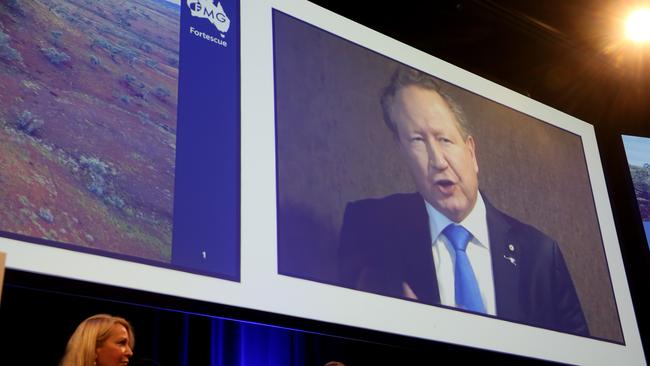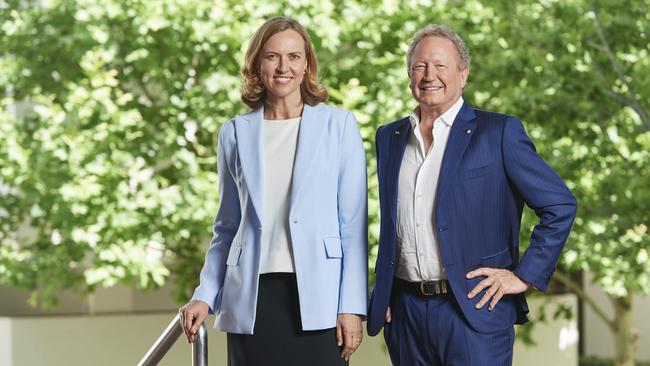Fortescue now marching ‘to the one beat’: Andrew Forrest
Andrew Forrest caught the market by surprise in 2020 when he laid out his vision for a green energy giant. And even after a tumultuous four years, he insists his dream is not dead.

Andrew Forrest caught the market by surprise when he stood up at Fortescue’s 2020 annual shareholder meeting and laid out a radical plan to transform the company into a green energy giant.
Iron ore prices were surging at the time, and Fortescue was wildly profitable. But Dr Forrest told shareholders attending the Fortescue AGM his green dream would take the company to a new level entirely, and by 2030 Fortescue would be challenging global energy majors such as Chevron.
Fortescue would be targeting production of as much as 235 gigawatts or renewable energy, Dr Forrest told shareholders - more than five times the capacity of Australia’s National Electricity Market at the time.
The edges of the plan had been leaking out for months, as Dr Forrest and a small group of insiders had been touring the world trying to stitch up deals with global governments to allow the company first choice of potential energy projects. The company’s new subsidiary, Fortescue Future Industries, had signed deal for the potential development of hydroelectric power in Papua New Guinea only a month before, along with early stage agreements in Indonesia. And the company had already hired a raft of renewable energy experts - including former Pacific Hydro boss Rob Grant - to help form its renewable energy plans.
By the November shareholder meeting Dr Forrest and his team had spoken with more than 25 governments around the world, with another 24 on the list for the touring party.
That landmark presentation in November 2020 kicked off a bewildering array of announcements from the tour - including early stage agreements with India, Indonesia, Brazil - and plans to get involved in the world’s biggest renewable energy project, the long-stalled Grand Inga project in the Democratic Republic of Congo.
Alarm bells were ringing in the market by mid-2021, however, when Fortescue’s announcement it planned to spend up to 10 per cent of its net profits on green energy projects - or $US400m to $US600m that financial year - sparked concerns the green energy project was looming as a major distraction from the company’s main iron ore business.

Fortescue chief executive Elizabeth Gaines faced a hostile reception from analysts and investors at the company’s regular quarterly production briefing in July, with analysts and fund managers demanding the company give the market a “clear business case” for its green energy investments. But resurgent iron ore prices meant the rivers of cash were still rolling in and the backlash never really translated into a hit to Fortescue’s share price - Dr Forrest argues the reverse happened, in fact, as green-focused investment firms piled into the company’s stock.
And the growing criticism certainly did not slow the flurry of announcements. By November 2021 FFI had inked agreements for hydrogen and renewable energy projects in more than 20 countries, and analysis by The Australian estimated that it would cost close to $200bn for Fortescue to make good on delivering just half of those projects.
By then FFI had more 700 staff, its own private jet to ferry energy boss Julie Shuttleworth around the world, and a vast portfolio of potential projects.
But even then cracks were appearing in Dr Forrest’s green vision. An investigation by The Weekend Australian in late 2021 revealed that the internal culture of FFI had become increasingly chaotic amid ruthless internal competition - so much so that insiders described its inner workings as being like the Hunger Games.
At the same time Dr Forrest’s passion for Fortescue’s project - which he genuinely believes is a key part of saving the planet from the worst impacts of global warming - riled up the rest of Australia’s mining industry, which until then had been watching on with bemused fascination, after The Australian revealed the Fortescue founder was lobbying for a phase-out of the federal government’s diesel fuel rebate scheme, worth billions to the mining industry.
Boiler room explosion
It is bizarre to reflect that catalogue only reflects the first year of Fortescue’s grand energy project.
Even close followers of the company amongst journalists and market analysts struggle to chronicle the bewildering array of announcements, promises and backflips - and executive departures - over the next few years.
But if there was a moment that sums up the chaos within the company, it is the complete implosion at the most senior ranks in the company in September 2021.
Newly appointed mining boss Fiona Hick left the company only days after Fortescue celebrated its 20th birthday with a lavish bash in the Pilbara. She was quickly followed out the door by new chief financial officer Christine Morris and high-profile FFI recruit Guy Debelle. In an explosive interview with The Australian, Dr Forrest claimed the extraordinary events were sparked after he returned from an overseas trip to find the company’s strategy had been hijacked by members of its executive team, over differences in opinion over Fortescue’s green strategy.
“You put a lighthouse on a hill and aim at it (but) there was a feeling that another lighthouse was emerging and the organisation – particularly when the chairman was overseas for three months – was being pushed towards another lighthouse,” he said at the time.
Is the dream over?
The spectacular departure of Hick and Morris did not end the upheaval in Fortescue’s executive ranks, far from it. But 10 months on, Fortescue now faces another round of major change as Dr Forrest this week reset the company’s strategy - finally conceding that the company’s most ambitious goal, of producing 15 million tonnes of green hydrogen a year by 2030, cannot be achieved in the face of soaring global energy costs.
But Dr Forrest rejects any suggestion the company’s green energy dream is dead. Speaking to The Australian this week, he said the company’s commitment to decarbonise its own iron ore operations by 2030 is unwavering, and the company will shift its green energy focus to building the massive amounts of wind and solar power needed to bring down energy costs and make hydrogen viable.
And as for the 700 staff that will leave as part of the reset? Dr Forrest says that is “heartbreaking”, but necessary as Fortescue brings its iron ore and green energy arms back together.
But the tension between those two arms has been at the centre of the chaos within Fortescue since the green energy project first began - according to both former Fortescue employees and Dr Forrest’s own words along the way.
‘There is no one else that is going to lead the world into a secure and non-fossil fuel future. It may as well be us, so it is us’
Andrew Forrest, Fortescue chairman
The decision to build Fortescue Energy as a company within a company was a deliberate decision, the Fortescue founder told The Australian this week, because it otherwise may not have happened at all.
“I had no choice. I tried for a couple of years to get green energy, and going green into the psyche of Fortescue. We had a very good, very well-run company, with shareholder returns which hit new records across Australia and tens of billions of dollars issued to shareholders. A super successful company - and strong resistance to change,” he said.
“And you can’t have improvement without change. You can’t be smug, fat and happy. And so as to not threaten the iron ore sector at all with a major new initiative, we did it through a major startup. And that grew and grew.”
Fortescue Energy had more than 1900 employees at the end of June 2023, according to the company’s last annual report. That may well be dramatically slimmed down by the latest restructuring.
But Dr Forrest says all of Fortescue is now “all marching in the same direction, to the same drum beat”.
“There is no one else that is going to lead the world into a secure and non-fossil fuel future. It may as well be us, so it is us,” he said. And Dr Forrest rejects any suggestion that Fortescue’s latest reset is a sign its green strategy is failing, pointing to the green iron technology the company is developing, its acquisition of a role developing in the giant Belinga iron ore deposit in Gabon, its early stage green ammonia joint venture in Morocco, and its development of new technology in shipping, trucking and rail.
“The failure here is a failure of your understanding - and I’m not being unkind here. We didn’t just go after green hydrogen, we went after green technology - we went after what opportunities there could be in changing the world. That led to opportunities being offered to us,” he said.




To join the conversation, please log in. Don't have an account? Register
Join the conversation, you are commenting as Logout